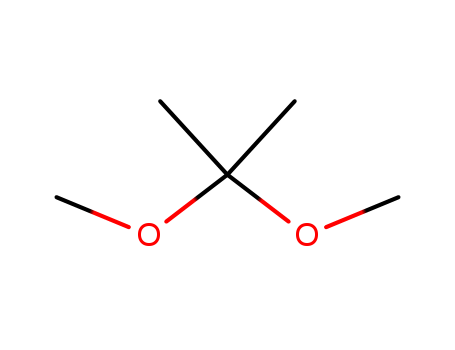10.1016/0008-6215(83)88254-8
This research aims to develop a convenient and practical method for synthesizing complex saccharides that are part of glycoconjugates. The study focuses on synthesizing a key intermediate compound for the production of a specific carbohydrate structure found in blood-group substances. The researchers used various chemicals, including benzyl alcohol, mercuric cyanide, hexamethyl-disilazane, chlorotrimethylsilane, acetic anhydride, and 2,2-dimethoxypropane, among others, to achieve the desired synthesis. The process involved multiple steps of acetylation, deacetylation, silylation, and isopropylidenation. The final product was obtained in good yields and its structure was confirmed through NMR spectroscopy. The study concludes that the synthesized intermediate could be a suitable precursor for the further synthesis of more complex oligosaccharides, potentially useful in the study of glycosidases, glycosyltransferases, and as synthetic antigens.
10.2478/s11696-013-0530-6
The research focuses on the synthesis, molecular structure, and evaluation of hemilabile imino-phosphine palladium(II) complexes in Heck reactions. The ligands 2-(diphenylphosphino)benzyl-(2-thiophene)methylimine (V) and 2-(diphenylphosphino)benzyl-(2-thiophene)ethylimine (VI) were prepared from 2-(diphenylphosphino)benzaldehyde and thiophene amines with high yields. These ligands were then reacted with PdCl2(cod) or PdClMe(cod) to form palladium(II) complexes I–IV. The molecular structure of complex II was confirmed by X-ray crystallography, revealing a distorted square planar geometry around the palladium atom. The complexes were evaluated as catalysts for the Heck coupling reactions of iodobenzene with methyl acrylate under mild conditions, showing significant activities with isolated yields of 64%, 68%, and 58% for complexes I, II, and IV, respectively. The study highlights the role of imino-phosphine ligands in enhancing catalytic activities due to their hemilabile property, which allows reversible protection of the coordination site.
10.1016/j.tetasy.2009.08.021
The research focuses on the total synthesis of marine polypropionates—siphonarienal, siphonarienone, and pectinatone—employing a desymmetrization strategy to create three consecutive stereogenic centers. The synthesis involves a series of chemical reactions starting from known precursors, utilizing reactants such as allyl bromide, LHMDS, LAH, 2,2-dimethoxypropane, CSA, Bn-Br, TsCl, Et3N, DMAP, LiAlH4, DDQ, and others as detailed in the experimental section. The synthesis steps include allylation, reductive ring opening, protection of hydroxyl groups, selective tosylation, reductive cleavage, and oxidation, among others. The synthesized compounds were analyzed using techniques like TLC, NMR, MS, and HRMS to confirm their structures and purities. The study also compares the efficiency of this strategy to previous methods, highlighting its advantage of creating three stereogenic centers in a single reaction, which is more efficient than the approximately 10 steps required by other methods.
10.1002/ejoc.200700579
The research focuses on the isolation, structural elucidation, and biosynthetic considerations of a series of unusual spiromacrolactones known as retipolides, derived from the mushrooms Retiboletus retipes and R. ornatipes. The main content of the research involves the identification and synthesis of these complex natural products, which are characterized by a 14-membered spiromacrolactone ring with a biphenyl ether linkage. The experiments utilized various analytical techniques, including high-resolution mass spectrometry (HRMS), nuclear magnetic resonance (NMR) spectroscopy, infrared (IR) spectroscopy, and ultraviolet-visible (UV/Vis) spectroscopy, to determine the molecular formulas, structures, and optical rotations of the retipolides. The researchers also employed single-crystal X-ray analysis to confirm the absolute configuration of certain retipolides. Additionally, the study explored the plausible biosynthetic pathways for these compounds, suggesting a sequence starting from a hypothetical 4-hydroxyphenyl derivative, named retipolide E. The reactants used in the synthesis and isolation processes included the mushroom extracts, various solvents for chromatography, and reagents for derivatization, such as 2,2-dimethoxypropane and p-toluenesulfonic acid. The analyses were crucial for the structural elucidation of retipolides A–E and their derivatives, as well as for the detection of probable biosynthetic intermediates in the fungal extract.
10.1016/0008-6215(84)85106-X
The study presents an optimized method for methylation analysis of oligo- and polysaccharides. The authors examined and refined each step of the procedure to enhance quantitative recovery and speed. Key chemicals involved include potassium methylsulphinyl carbanion, generated from potassium hydride, which is used to form polyalkoxide ions necessary for methylation. Methyl iodide is employed for the methylation of these ions. Other reagents such as trifluoroacetic acid for hydrolysis, sodium borohydride for reduction, and acetic anhydride for acetylation are used in subsequent steps to convert the methylated carbohydrates into analyzable derivatives. The study also utilizes 2,2-dimethoxypropane to remove residual water after washing steps, ensuring efficient evaporation and isolation of the methylated products. The improved procedure allows for complete methylation, high recoveries of acetylated alditols of methylated sugars, and the analysis to be completed within a working day, making it a convenient and efficient method for determining glycosyl linkages in a wide range of oligo- and polysaccharides.



 F,
F, Xi
Xi


